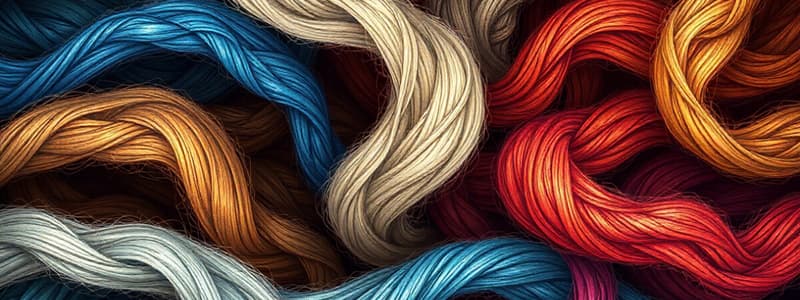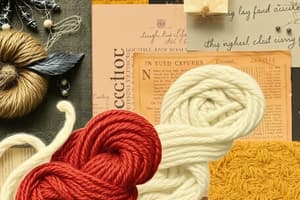Podcast
Questions and Answers
What is the minimum ratio considered essential for processing fibers?
What is the minimum ratio considered essential for processing fibers?
- 150
- 50
- 100 (correct)
- 200
What is tenacity in the context of fibers?
What is tenacity in the context of fibers?
- The amount of twist in a fiber
- The ability of a fiber to bend without breaking
- The maximum stress needed to rupture a fiber (correct)
- The durability of a fiber
What unit is typically used to express tensile strength in grams per denier?
What unit is typically used to express tensile strength in grams per denier?
- g/d (correct)
- kg/m
- gf/mm²
- mN/t
Which type of fiber is known for having good flexibility?
Which type of fiber is known for having good flexibility?
What are fibers primarily defined as?
What are fibers primarily defined as?
Why is cohesiveness less important for filament fibers compared to staple fibers?
Why is cohesiveness less important for filament fibers compared to staple fibers?
What is the typical length range for staple fibers?
What is the typical length range for staple fibers?
What indicates the mass in grams of 9,000 meters of material?
What indicates the mass in grams of 9,000 meters of material?
What can result from using stiff, inflexible fibers?
What can result from using stiff, inflexible fibers?
Which of the following best describes filaments?
Which of the following best describes filaments?
What property describes individual fibers holding onto one another when spun into yarn?
What property describes individual fibers holding onto one another when spun into yarn?
What is the minimum length to width ratio (L/W) required for proper processing of fibers?
What is the minimum length to width ratio (L/W) required for proper processing of fibers?
Which property is not considered a primary fiber property?
Which property is not considered a primary fiber property?
Why is fiber length an important property?
Why is fiber length an important property?
What is a characteristic of natural fibers in terms of their length form?
What is a characteristic of natural fibers in terms of their length form?
Which property is not listed as a primary fiber property?
Which property is not listed as a primary fiber property?
Flashcards
Fiber
Fiber
Fundamental units of textiles, long, slender thread-like structures, smallest entities of textiles, units of matter spun into yarn or fabric.
Staple Fiber
Staple Fiber
Short fibers measured in inches or centimeters, range from 2-46 cm, natural fibers are only in staple form
Filament Fiber
Filament Fiber
Long continuous fibers, ranging in length from hundreds of meters to kilometers, thickness similar to fibers.
Fiber Length
Fiber Length
Signup and view all the flashcards
Length to Width Ratio (L/W)
Length to Width Ratio (L/W)
Signup and view all the flashcards
Primary Fiber Properties
Primary Fiber Properties
Signup and view all the flashcards
Secondary Fiber Properties
Secondary Fiber Properties
Signup and view all the flashcards
Tensile Strength
Tensile Strength
Signup and view all the flashcards
Tenacity
Tenacity
Signup and view all the flashcards
Linear Density
Linear Density
Signup and view all the flashcards
Denier
Denier
Signup and view all the flashcards
Tex
Tex
Signup and view all the flashcards
Fiber Flexibility
Fiber Flexibility
Signup and view all the flashcards
Cohesiveness
Cohesiveness
Signup and view all the flashcards
Spinning Quality
Spinning Quality
Signup and view all the flashcards
Minimum Ratio
Minimum Ratio
Signup and view all the flashcards
Fiber Uniformity
Fiber Uniformity
Signup and view all the flashcards
Staple Fibers
Staple Fibers
Signup and view all the flashcards
Manufactured Fibers
Manufactured Fibers
Signup and view all the flashcards
Fiber Length
Fiber Length
Signup and view all the flashcards
Study Notes
Textile Fibre Properties
- Fibers are the fundamental units of textiles
- Fibers are long, slender thread-like structures of cells
- Fibers are the smallest entities of textiles
- Fibers can be spun into yarn or made into fabric
Staple Fibre
- Staple fibers are short fibers measured in inches or centimeters
- Staple fibers range from 2 to 46 cm in length.
- Natural fibers are only available in staple form
- Staple fibers may be natural or continuous fibers cut to a staple length
Filament
- Filament fibers are long continuous fibrous structures
- Filament fibers range from a few hundred meters (silk) to several kilometers (man-made fibers)
- Filament fiber thickness is similar to that of fibers
Fibre Classification
- Fibers are classified as natural or man-made
- Natural fibers are further classified as natural vegetable, natural animal, and natural mineral
- Natural vegetable fibers include seed fibers (cotton), bast fibers (jute, linen, flax, ramie, kenaf), and leaf fibers (abaca, banana, sisal, henequen, flax, ramie, hemp, sunn, and coir)
- Natural animal fibers include wool, silk, and hair
- Natural mineral fibers include asbestos
- Man-made fibers are further classified as regenerated man-made fibers, synthetic man-made fibers, and other man-made fibers
- Regenerated man-made fibers include cellulose, viscose, protein, acetate, alginate, and lyocell
- Synthetic man-made fibers include polyester, polyvinyl, acrylic, polyolefin, and others
- Other man-made fibers include metallic fibers, glass fibers, and carbon fibers
- Natural fibers are further classified as natural vegetable, natural animal, and natural mineral
Primary Fibre Properties
-
Length to width ratio:
- Average fiber length (minimum 5mm) determines overall quality and utility
- Ratio of 1:100 is essential for processing, most fibers have significantly higher ratios
- Fibers shorter than 1.3 cm are seldom used in yarn manufacturing
-
Strength:
- Tensile strength, measured in psi or gf/mm², is the force needed to rupture a fiber
- Tenacity is tensile strength expressed as force per unit of linear density, typically in grams per denier or grams per tex.
- Examples of units used to express tensile strength include psi and gf/mm².
- Linear density units include denier (mass in grams of 9,000 meters of material) and tex (mass in grams of 1,000 meters of material)
-
Flexibility:
- The ability of a fiber to bend and fold without breaking
- Flexible fibers wrap around other fibers during spinning, create drape and hand in yarns and fabrics, and are easier to spin into yarns.
- Stiff fibers are difficult to spin into thread and create fabrics with poor drape. Cellulosic fibers are flexible.
-
Cohesiveness:
- The ability of fibers to stick together as a single unit
- Cohesion is less important for filament fibers than for staple fibers
-
Uniformity:
- Allows fibers to be processed together with less difficulty.
- Manufactured fibers are virtually identical in a run or lot.
- Natural fibers are subject to growth irregularities and are not uniform.
Secondary Fibre Properties
- Color: Fiber color affects the final product's appearance.
- Recovery: Fiber ability to retain its shape or form after being subjected to external forces.
- Luster: Fiber's shininess or reflective quality.
- Thermal properties: Fiber reaction to heat, often affecting the final fabric's comfort.
- Resiliency: Fiber's ability to return to its original shape after being bent, compressed, or stretched.
- Elongation: Fiber's ability to stretch before breaking.
- Abrasion resistance: Fiber's ability to resist damage from rubbing or friction.
- Moisture absorption: Fiber's ability to absorb moisture.
Studying That Suits You
Use AI to generate personalized quizzes and flashcards to suit your learning preferences.




